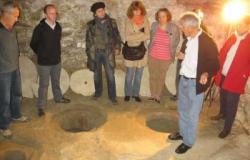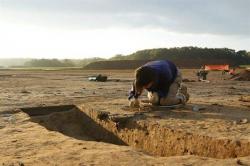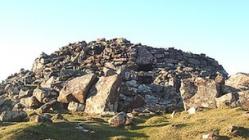14 NOVEMBRE
INDI-UNI : ANTHROPOLOGY - ARCHAEOLOGY
INSCRIPTION 2011 – 2012 COURS A DISTANCE
REGISTRATION 2011 – 2012 ONLINE COURSES
USA – Fort de Chartres - The buried remains of the only 18th century Illinois frontier log fort not to have been washed away in floods long ago or destroyed by modern construction have been found beside Illinois 155 near the Fort de Chartres State Historic Site. It is a previously unknown fort that was called Fort de Chartres. While it is well-recorded that two nearby early wood forts built by the French military, each known as Fort de Chartres, were successively constructed in 1721 and 1725 on separate sites nearer the Mississippi River, "It wasn't until recently we knew there was a third (wood) fort," said retired archaeologist Margaret K. Brown. This fort was occupied from 1732 to 1751. Brown, a former state archaeologist and former director of the Cahokia Mounds State Historic Site in Collinsville, helped lead the excavation with Robert Mazrim, an archaeologist with the Illinois State Archaeological Survey and an expert on French Colonial Illinois. We have excavated about a half dozen houses from the period in this area, but we have never, ever had a chance to look at something so well-preserved, such a single component. It's not been complicated by other kinds of remains or occupations." The discovery brings the total number of Illinois forts named de Chartres to four, three made of logs and the current 1754 stone fort state site, a complete restoration using some of the original blocks of limestone.
http://www.bnd.com/2011/11/13/1939704/eureka-archaeologists-uncover.html#ixzz1dhqvXjD2
BELGIQUE –  Furnes - A Furnes (Flandre occidentale) des vestiges archéologiques ont été mis à jour, vraisemblablement des fondations des portes de la ville datant du 14ème siècle. La découverte a été faite lors de travaux d’excavation pour la construction d’un immeuble d’appartements. Il s’agit de fondations rondes en briques jaunes. Selon certains, Il s’agirait vraisemblablement des vestiges des portes de la ville datant du 14ème siècle. D’autres optent pour des vestiges de deux tours de guet qui faisaient partie des fortifications de la ville et qui se trouvaient sur les remparts. Au 14ème siècle Furnes était une ville fortifiée.
Furnes - A Furnes (Flandre occidentale) des vestiges archéologiques ont été mis à jour, vraisemblablement des fondations des portes de la ville datant du 14ème siècle. La découverte a été faite lors de travaux d’excavation pour la construction d’un immeuble d’appartements. Il s’agit de fondations rondes en briques jaunes. Selon certains, Il s’agirait vraisemblablement des vestiges des portes de la ville datant du 14ème siècle. D’autres optent pour des vestiges de deux tours de guet qui faisaient partie des fortifications de la ville et qui se trouvaient sur les remparts. Au 14ème siècle Furnes était une ville fortifiée.
http://www.sporza.be/cm/vrtnieuws.francais/magazine/111113_Furnes_fr
FRANCE –  Lautrec - Opération portes ouvertes ce samedi matin à la maison Leblanc de la Caussade - -pour une présentation de la vingtaine de silos que recèlent les fondements de cette maison. La visite de ce samedi était étayée d'un joli diaporama et des explications du président sur l'utilité de ces silos au Moyen Âge « Nous pouvons dire qu'ils ont été creusés entre le XIVe jusqu'à la fin du XVIe siècle, mais peut-être aussi avant, ils servaient de réservoir à grains et étaient des outils de spéculations (déjà !). Car le grain ainsi entreposé, bien tassé et à l'abri de toute rentrée d'air se conservait parfaitement. Le blé était vendu quand la demande était là ». Les silos étaient fermés par un opercule en silex bien bouché avec de la terre glaise. Le village de Lautrec construit sur une colline de gré recèle un grand nombre de ces silos « à notre connaissance environ 200 silos sont répertoriés, ce qui fait de Lautrec le premier village en France à avoir une telle densité de silos.
Lautrec - Opération portes ouvertes ce samedi matin à la maison Leblanc de la Caussade - -pour une présentation de la vingtaine de silos que recèlent les fondements de cette maison. La visite de ce samedi était étayée d'un joli diaporama et des explications du président sur l'utilité de ces silos au Moyen Âge « Nous pouvons dire qu'ils ont été creusés entre le XIVe jusqu'à la fin du XVIe siècle, mais peut-être aussi avant, ils servaient de réservoir à grains et étaient des outils de spéculations (déjà !). Car le grain ainsi entreposé, bien tassé et à l'abri de toute rentrée d'air se conservait parfaitement. Le blé était vendu quand la demande était là ». Les silos étaient fermés par un opercule en silex bien bouché avec de la terre glaise. Le village de Lautrec construit sur une colline de gré recèle un grand nombre de ces silos « à notre connaissance environ 200 silos sont répertoriés, ce qui fait de Lautrec le premier village en France à avoir une telle densité de silos.
http://www.ladepeche.fr/article/2011/11/09/1211256-lautrec-archeologie-visite-des-silos-mis-a-jour-cet-ete.html
FRANCE –  Chavagne - Depuis septembre et jusqu'à décembre, une équipe de sept archéologues de l'Institut national de recherches archéologiques préventives (Inrap) étudie minutieusement deux sites. Le premier est situé au nord de la ferme de la Touche, le second à quelques centaines de mètres plus à l'ouest. Cette opération permet déjà de supposer que des populations humaines ont vécu sur ces sites depuis le Néolithique et surtout lors des périodes de l'âge du Bronze (1500-1200 avant notre ère), de l'Antiquité et du début du Moyen-Âge. Actuellement, les curieux qui se rendent sur ces sites n'y découvrent que quelques trous de différentes tailles dans le sol argileux. Joseph Le Gall, responsable des opérations, donne une autre dimension à ce chantier : « Nous avions ici une grande grange de l'époque gallo-romaine, en terre et en bois, maintenue par des poteaux de calage larges, et entourée d'un fossé de drainage. » Pour mettre au jour ce genre de découvertes, les archéologues commencent par décaisser une épaisse couche de terre végétale. « En dessous, on arrive sur le sol naturel, un sol qui n'a pas été remanié par l'homme, sauf à certains endroits ». C'est à ces endroits, où on voit que la terre n'a pas la même couleur, la même texture ou le même niveau, que l'équipe d'archéologues repère des traces d'anciennes occupations. « On étudie les poubelles du passé ! On trouve des ossements d'animaux, ce qui nous permet de dire quels animaux ils élevaient, et on fait des prélèvements dans le sol pour définir quelles céréales étaient cultivées », résume Joseph Le Gall. Pour ces résultats de prélèvements, il faut encore attendre le mois de décembre. Mais plusieurs indices, comme la découverte de fragments de céramiques, prouvent déjà sur le premier site l'existence d'un bâtiment de l'âge du Bronze et de cette grange gallo-romaine. Un morceau de maillet du Néolithique a même été retrouvé. Sur le second site, les découvertes sont inédites : l'occupation humaine y daterait du tout début du Moyen-Âge, voire de l'Antiquité. Le bourg de Chavagne existerait donc depuis le II e siècle !
Chavagne - Depuis septembre et jusqu'à décembre, une équipe de sept archéologues de l'Institut national de recherches archéologiques préventives (Inrap) étudie minutieusement deux sites. Le premier est situé au nord de la ferme de la Touche, le second à quelques centaines de mètres plus à l'ouest. Cette opération permet déjà de supposer que des populations humaines ont vécu sur ces sites depuis le Néolithique et surtout lors des périodes de l'âge du Bronze (1500-1200 avant notre ère), de l'Antiquité et du début du Moyen-Âge. Actuellement, les curieux qui se rendent sur ces sites n'y découvrent que quelques trous de différentes tailles dans le sol argileux. Joseph Le Gall, responsable des opérations, donne une autre dimension à ce chantier : « Nous avions ici une grande grange de l'époque gallo-romaine, en terre et en bois, maintenue par des poteaux de calage larges, et entourée d'un fossé de drainage. » Pour mettre au jour ce genre de découvertes, les archéologues commencent par décaisser une épaisse couche de terre végétale. « En dessous, on arrive sur le sol naturel, un sol qui n'a pas été remanié par l'homme, sauf à certains endroits ». C'est à ces endroits, où on voit que la terre n'a pas la même couleur, la même texture ou le même niveau, que l'équipe d'archéologues repère des traces d'anciennes occupations. « On étudie les poubelles du passé ! On trouve des ossements d'animaux, ce qui nous permet de dire quels animaux ils élevaient, et on fait des prélèvements dans le sol pour définir quelles céréales étaient cultivées », résume Joseph Le Gall. Pour ces résultats de prélèvements, il faut encore attendre le mois de décembre. Mais plusieurs indices, comme la découverte de fragments de céramiques, prouvent déjà sur le premier site l'existence d'un bâtiment de l'âge du Bronze et de cette grange gallo-romaine. Un morceau de maillet du Néolithique a même été retrouvé. Sur le second site, les découvertes sont inédites : l'occupation humaine y daterait du tout début du Moyen-Âge, voire de l'Antiquité. Le bourg de Chavagne existerait donc depuis le II e siècle !
http://www.ouest-france.fr/actu/actuLocale_-Un-maillet-et-des-ceramiques-decouverts-sur-le-site-neolitique-_35076-avd-20111109-61635321_actuLocale.Htm
ROYAUME UNI –  Assynt - Radiocarbon dating of burnt twigs found inside an ancient building in Assynt suggest its interior remained untouched after it was built in the Iron Age. Brochs were often modified during later periods of use. One at Nybster in Caithness has evidence of possible Pictish and medieval occupation. The dating of twigs possibly used for woven mats points to the Assynt site remaining unaltered until it collapsed. The broch at Clachtoll was built using stones weighing up to 100kg each. Archaeologists involved in a community project called Life and Death in Assynt's Past had expected the burnt wood to date from AD 300 to AD 1000, during the building's final phase of occupation. However, tests at AOC Archaeology's laboratory in Midlothian dated it to 111 BC and AD 55, suggesting generations of families left the interior unaltered from the time it was created. A spokeswoman for the project said: "The possibility that we have a genuine Iron Age broch interior, untrammelled by later modification of admixture, is very exciting indeed." Built of stone, circular tower-like brochs were impressive homes in some of Scotland's Iron Age communities.
Assynt - Radiocarbon dating of burnt twigs found inside an ancient building in Assynt suggest its interior remained untouched after it was built in the Iron Age. Brochs were often modified during later periods of use. One at Nybster in Caithness has evidence of possible Pictish and medieval occupation. The dating of twigs possibly used for woven mats points to the Assynt site remaining unaltered until it collapsed. The broch at Clachtoll was built using stones weighing up to 100kg each. Archaeologists involved in a community project called Life and Death in Assynt's Past had expected the burnt wood to date from AD 300 to AD 1000, during the building's final phase of occupation. However, tests at AOC Archaeology's laboratory in Midlothian dated it to 111 BC and AD 55, suggesting generations of families left the interior unaltered from the time it was created. A spokeswoman for the project said: "The possibility that we have a genuine Iron Age broch interior, untrammelled by later modification of admixture, is very exciting indeed." Built of stone, circular tower-like brochs were impressive homes in some of Scotland's Iron Age communities.
http://www.bbc.co.uk/news/uk-scotland-highlands-islands-15719750S
BULGARIE - Bulgaria's National History Museum will put on display about 10 000 "extremely valuable" archaeological finds and artifacts. The finds in question were seized from a treasure hunting and antiques trafficking crime group back in 2004. They feature archaeological items from various ages – from prehistory all the way to the 20th century. Some of the more interesting treasures to be put on display include: 22 silver coins from the rule of medieval Bulgarian Tsar Mihail Shishman (1323-1330 AD); 154 silver coins minted in the northwest of the Second Bulgarian Empire in the 14th century, as well as Venetian and Serbian coins; 56 silver coins minted by the last ruler of the Second Bulgarian Empire before it was conquered by the Ottoman Turkish Empire – Tsar Ivan Sratsimir, who was killed in 1396 AD by the Ottomans. Over 100 silver coins from the ruler of Ivan Sratsimir's brother, Tsar Ivan Shishman (r. 1371-1939 AD); another set of 1 111 silver coins minted by both Tsar Ivan Shishman and the Ottoman Turkish sultan Bayazid I, who conquered most of medieval Bulgaria (most of these coins were kept by the traffickers in a shampoo bottle, the museum pointed out). Several lead seals belonging to medieval Bulgarian Tsars from the period of the First Bulgarian Empire (681-1018 AD) which are of extreme historic value, including – one seal that belonged to Tsar Boris I who formally introduced Christianity to Bulgaria (r. 852-889 AD); 4 seals that belonged to Tsar Simeon I The Great (r. 893-927 AD); 5 seals that belonged to Tsar Petar I (r. 927-971 AD). Gold and silver decorations created by the smiths in the Bulgarian Catholic center of Chiprovtsi in the 17th and 18th century. A silver image of Virgin Mary from Byzantium's iconoclastic period from the 7th century AD crafted in the "Antioch style". A metal image for St. Nikola from the 12-13th century from medieval Bulgaria. A seal from 1867 AD that belonged to key Bulgarian revolutionary and freedom fighter Georgi S. Rakovski who fought for Bulgaria's Liberation from the Ottoman Turkish Empire. A state order from the Third Bulgarian Empire ( State ) in the name of St. Cyril and St. Methodius that is believed to have belonged to Tsar Boris III (r. 1918-1943).
http://www.novinite.com/view_news.php?id=133927